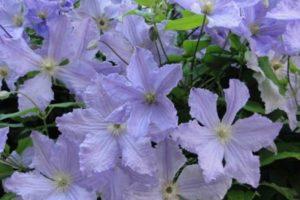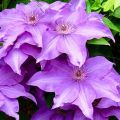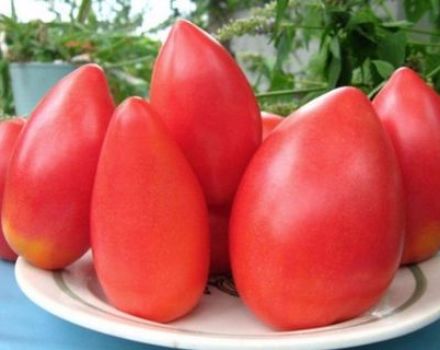Description and characteristics of clematis variety Niobe, planting scheme and care
Clematis of the Niobe variety is a member of the Buttercup family, it is a perennial herb. In the wild, it grows in countries with subtropical or temperate climates. In Russia, Belarus, Ukraine, the flower is also grown, thanks to the efforts of breeders. They bred the winter-hardy variety Niobe. To successfully plant a culture, to properly care for it, you should familiarize yourself with the tips below.
Description and features
Clematis is a perennial hybrid flower with vines growing up to 3 meters in height. The plant is kept on planes by strong antennae. The leaves are trifoliate, richly emerald.
Large inflorescences with a diameter of 15 cm in various shades of red: burgundy, crimson, purple. In the middle there are elongated stamens of a bright yellow tone, along the edges of 6 petals there is a slight curliness. Pollen starts from the 2nd year, lasts from June to November. Supports are required to strengthen long vines, depending on the artistic composition conceived by the owner of the garden. Clematis is planted along high fences, trees, on arches.
There are such varieties of clematis by the pruning method:
- the first group - the formation of flower ovaries is carried out only on last year's vines;
- the second group - pollen on the growths of the current year, partly on the branches of the past;
- the third group - buds bloom only on vines that have grown in the current season.
Clematis is a capricious plant in terms of care, but if desired, even an inexperienced gardener can grow it. It can be planted in the garden or at home to decorate balconies, gazebos.
Origin of the variety
The large-flowered clematis niobe was bred by the Polish breeder W. Knoll in 1975. He belongs to the Zhakman group. Culture gained popularity in the CIS countries in the 1980s.
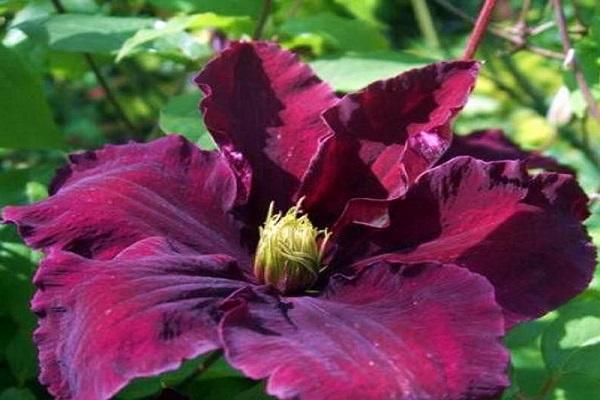
Landing
Clematis should be planted according to the standard pattern for planting vines. The variety does not imply special agrotechnical nuances.
Site requirements
It is advisable to plant clematis in lighted places, with no drafts. The culture grows well in partial shade.
Soil selection and preparation
The soil should be fertile, moist, loose, well-drained. Stagnation of moisture, acidic earth is unacceptable, otherwise the vine will develop poorly or not bloom.
2 weeks before planting, plow the soil with a spade bayonet to remove weeds and improve aeration. Cover with compost, sawdust or bark. Immediately before disembarking, loosen the ground with a half-bayonet hoe.If the soil is acidic, add sand, humus to it, arrange for proper drainage.
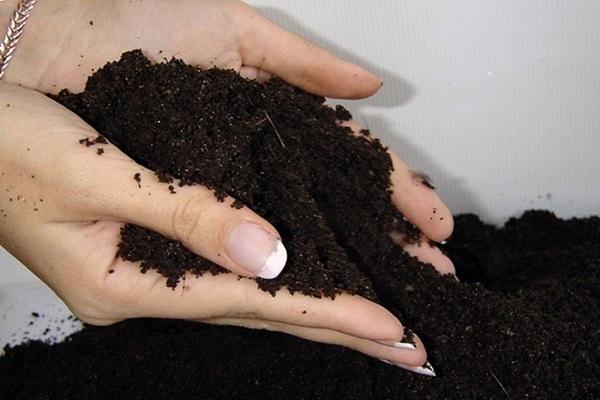
Timing
Depending on the climatic conditions of the region, clematis is planted in the off-season. In the North, planting is carried out in the spring, in the southern regions - in the fall. It is advisable to plant rhizomes from mid-April to the last days of May, from September to the first half of October.
Selection and preparation of planting material
The main rule when selecting seedlings is to buy them only from trusted sellers or nurseries specializing in the production of climbing ornamental plants. When buying, you should pay attention to the trimming group. Choose clematis seedlings without damage, traces of diseases, beetles. They must be strong, healthy looking.
Before planting clematis, sort the seedlings again. After, place it in the solution to stimulate the development of the rhizomes "Matador", "Epin" for 30 minutes.
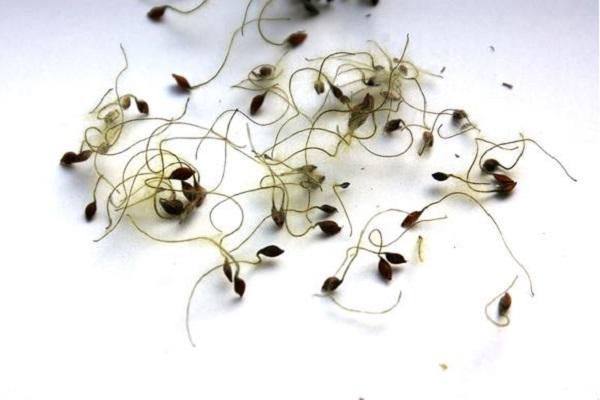
Landing scheme
Transfer the seedlings of clematis to the heated ground, having previously dug holes at a distance of 1 meter. Their depth should be 50 cm, a layer of pebble and gravel drainage is laid on the bottom. After that, put humus, compost, sand and peat in the holes, this will give the earth fertility. Tamp the soil next to the clematis, pour plenty of water. It is imperative to mulch the soil.
Care
You need to take care of clematis regularly. He needs timely watering, loosening, shelter for the winter, pruning. It is also important to process the vine from diseases, harmful beetles.
Watering
Clematis is watered as the soil dries up. It is advisable to irrigate the vine with settled water. There should be no stagnation of moisture; normally, 2 waterings per week are carried out. Add 10 liters of water per 1 square meter.
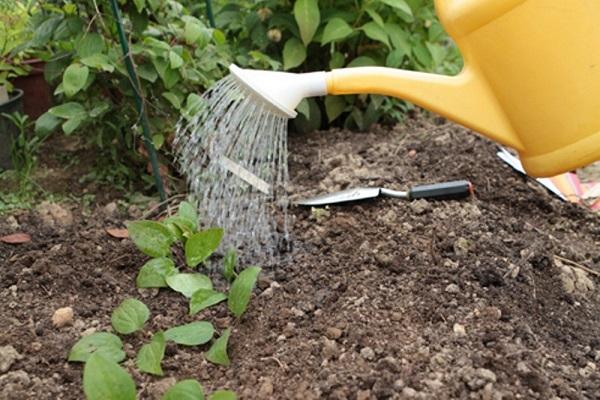
Loosening and weeding
In autumn and spring, mulch the ground with green manure, dig the area around the climbing plant on the floor with a shovel bayonet. Loosening is carried out in parallel with the removal of weeds 3 times a month.
Top dressing
Clematis is fertilized with organic matter, minerals, in the spring. In the course of active growth and pollen, it is fed with complex compounds, including phosphorus, nitrogen, potassium.
Trimming group
Clematis Niobe is pruned in the third group. In autumn, the shoots are shortened thoroughly, leaving 2-3 knots above the ground. In mid-latitudes, plants survive the winter safely under a thick layer of mulch, and in the North - under shelters. In the South, the vine is formed according to the second pruning group, which allows to increase the flowering period and get the first flowers on preserved branches from the last season.
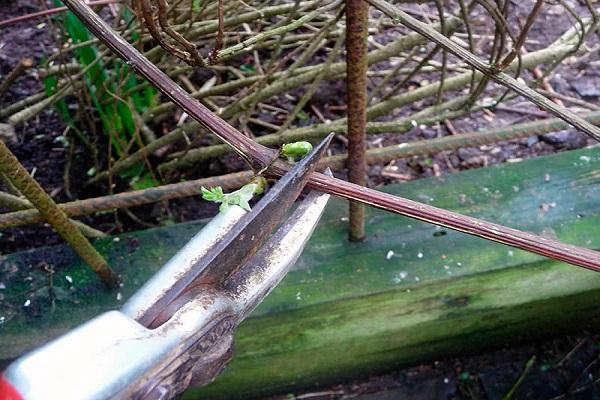
Shelter for the winter
Clematis is famous for its increased resistance to cold weather, withstands frosts down to -40 degrees. To be on the safe side, you can use insulating shelters from a layer of sawdust 20 cm, peat 10 cm.
Disease and pest control
Liana has an average immunity to diseases, beetles, sometimes it is affected by sudden pathologies, pests. Experienced gardeners recommend carrying out preventive treatments in the spring with chemicals like Fundazol, Actelik, copper sulfate, Bordeaux liquid. Also, proper care can enhance the protective properties of the culture.
Reproduction
Clematis is bred 5-6 years after disembarkation. You can propagate it by cuttings, dividing the bush, rooting cuttings. The variety is usually propagated by the first method. From an adult bush, in spring or early June, petioles are cut up to 20 cm long, with 3-4 healthy buds, planted in a separate place or in a container for the purpose of rooting. In the fall, they are sheltered before the onset of cold weather. In the spring they are planted in a separate place.

Decorative use
For garden decoration, clematis is ideal. It is in harmony with green bushes, chamomiles, petunias, the Astrov family.You can plant liana in tandem with trees of medium height.
Multi-tiered compositions are created from clematis, they are used to decorate gardens and parks.
Reviews
Gardeners speak positively about clematis Niobe, their responses will help to find out more information about the plant.
Pavel Cherkasov, 69 years old, Vinnitsa

Hello! I grow Clematis Niobe on the arch of the entrance gate, delighted with it. The plant blooms with gorgeous flowers, creates a romantic atmosphere. I learned about the variety from a magazine in 2003.
Roman Pavlov, 48 years old, Sumy
Greetings! There are only positive impressions about the clematis Niobe variety. I use it to decorate the gazebo in the country. It blooms in a violent, crimson color from the beginning of summer until the arrival of frost.
Larisa Ukupnik, 60 years old, Dnipro
Hello to all! In the spring of 2005, I bought seedlings of clematis Niobe on the market, since then, it flaunts in my garden. I planted it along the garage as a decoration. The plant is not particularly demanding in care, apart from pruning.
